Comprehensive Guide to Creating and Utilizing NumPy Empty 2D Arrays
NumPy empty 2D array is a powerful tool in the NumPy library for creating uninitialized arrays quickly and efficiently. This article will delve deep into the concept of NumPy empty 2D arrays, exploring their creation, manipulation, and various applications in scientific computing and data analysis.
Understanding NumPy Empty 2D Arrays
NumPy empty 2D array is a fundamental concept in NumPy, the popular numerical computing library for Python. Unlike other array creation functions like zeros() or ones(), the empty() function creates an array without initializing its elements. This can lead to significant performance improvements when working with large datasets.
What is a NumPy Empty 2D Array?
A NumPy empty 2D array is a two-dimensional array created using the numpy.empty() function. The array is allocated in memory, but its contents are not initialized. This means that the values in the array are arbitrary and depend on the state of the memory at the time of allocation.
Let’s create a simple NumPy empty 2D array:
import numpy as np
# Create a 3x3 NumPy empty 2D array
empty_2d_array = np.empty((3, 3))
print("NumPy empty 2D array from numpyarray.com:")
print(empty_2d_array)
Output:

In this example, we create a 3×3 NumPy empty 2D array. The values in the array are uninitialized and may contain arbitrary data.
Why Use NumPy Empty 2D Arrays?
NumPy empty 2D arrays are particularly useful when you plan to fill the array with values immediately after creation. By skipping the initialization step, you can achieve better performance, especially when working with large arrays.
Here’s an example demonstrating the performance advantage:
import numpy as np
import time
# Measure time to create a large NumPy empty 2D array
start_time = time.time()
large_empty_array = np.empty((10000, 10000))
end_time = time.time()
print(f"Time to create empty array from numpyarray.com: {end_time - start_time} seconds")
# Measure time to create a large NumPy zeros 2D array
start_time = time.time()
large_zeros_array = np.zeros((10000, 10000))
end_time = time.time()
print(f"Time to create zeros array from numpyarray.com: {end_time - start_time} seconds")
Output:

This example compares the time taken to create a large NumPy empty 2D array versus a NumPy zeros 2D array. You’ll notice that the empty array creation is significantly faster.
Creating NumPy Empty 2D Arrays
Now that we understand the basics of NumPy empty 2D arrays, let’s explore various ways to create them.
Basic Creation of NumPy Empty 2D Arrays
The most straightforward way to create a NumPy empty 2D array is using the numpy.empty() function. Here’s an example:
import numpy as np
# Create a 4x5 NumPy empty 2D array
empty_2d_array = np.empty((4, 5))
print("4x5 NumPy empty 2D array from numpyarray.com:")
print(empty_2d_array)
Output:

In this example, we create a 4×5 NumPy empty 2D array. The shape of the array is specified as a tuple (4, 5).
Specifying Data Type
You can specify the data type of the NumPy empty 2D array using the dtype parameter:
import numpy as np
# Create a 3x3 NumPy empty 2D array with float64 data type
empty_2d_array_float64 = np.empty((3, 3), dtype=np.float64)
print("Float64 NumPy empty 2D array from numpyarray.com:")
print(empty_2d_array_float64)
# Create a 3x3 NumPy empty 2D array with int32 data type
empty_2d_array_int32 = np.empty((3, 3), dtype=np.int32)
print("Int32 NumPy empty 2D array from numpyarray.com:")
print(empty_2d_array_int32)
Output:
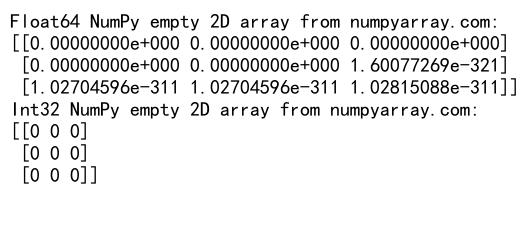
This example demonstrates creating NumPy empty 2D arrays with specific data types. The dtype parameter allows you to control the precision and memory usage of your arrays.
Creating Empty 2D Arrays with Complex Numbers
NumPy empty 2D arrays can also be created to hold complex numbers:
import numpy as np
# Create a 2x2 NumPy empty 2D array with complex numbers
empty_2d_array_complex = np.empty((2, 2), dtype=np.complex128)
print("Complex NumPy empty 2D array from numpyarray.com:")
print(empty_2d_array_complex)
Output:

This example creates a 2×2 NumPy empty 2D array that can hold complex numbers with double precision.
Manipulating NumPy Empty 2D Arrays
Once you’ve created a NumPy empty 2D array, you can manipulate it in various ways. Let’s explore some common operations.
Filling NumPy Empty 2D Arrays
After creating a NumPy empty 2D array, you’ll often want to fill it with specific values. Here’s how you can do that:
import numpy as np
# Create a 3x3 NumPy empty 2D array
empty_2d_array = np.empty((3, 3))
# Fill the array with a specific value
empty_2d_array.fill(42)
print("Filled NumPy 2D array from numpyarray.com:")
print(empty_2d_array)
Output:
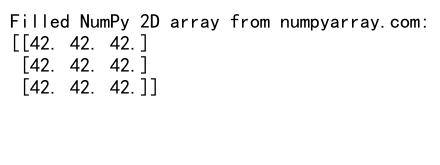
In this example, we create a 3×3 NumPy empty 2D array and then fill it with the value 42 using the fill() method.
Reshaping NumPy Empty 2D Arrays
You can change the shape of a NumPy empty 2D array using the reshape() method:
import numpy as np
# Create a 3x4 NumPy empty 2D array
empty_2d_array = np.empty((3, 4))
# Reshape the array to 2x6
reshaped_array = empty_2d_array.reshape((2, 6))
print("Reshaped NumPy 2D array from numpyarray.com:")
print(reshaped_array)
Output:

This example demonstrates reshaping a 3×4 NumPy empty 2D array into a 2×6 array. Note that the total number of elements must remain the same during reshaping.
Transposing NumPy Empty 2D Arrays
Transposing a NumPy empty 2D array is straightforward using the T attribute:
import numpy as np
# Create a 2x3 NumPy empty 2D array
empty_2d_array = np.empty((2, 3))
# Transpose the array
transposed_array = empty_2d_array.T
print("Transposed NumPy 2D array from numpyarray.com:")
print(transposed_array)
Output:

This example shows how to transpose a 2×3 NumPy empty 2D array, resulting in a 3×2 array.
Advanced Operations with NumPy Empty 2D Arrays
NumPy empty 2D arrays support a wide range of advanced operations. Let’s explore some of these capabilities.
Slicing NumPy Empty 2D Arrays
You can extract specific parts of a NumPy empty 2D array using slicing:
import numpy as np
# Create a 5x5 NumPy empty 2D array and fill it with random integers
empty_2d_array = np.empty((5, 5), dtype=int)
empty_2d_array[:] = np.random.randint(0, 100, size=(5, 5))
# Slice the array to get a 3x3 subarray
sliced_array = empty_2d_array[1:4, 1:4]
print("Sliced NumPy 2D array from numpyarray.com:")
print(sliced_array)
Output:
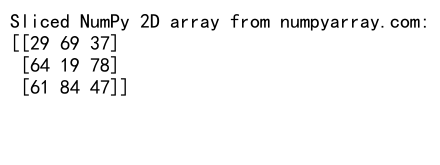
This example creates a 5×5 NumPy empty 2D array, fills it with random integers, and then extracts a 3×3 subarray using slicing.
Broadcasting with NumPy Empty 2D Arrays
Broadcasting is a powerful feature in NumPy that allows operations between arrays of different shapes:
import numpy as np
# Create a 3x3 NumPy empty 2D array and fill it with random integers
empty_2d_array = np.empty((3, 3), dtype=int)
empty_2d_array[:] = np.random.randint(0, 10, size=(3, 3))
# Create a 1D array for broadcasting
broadcast_array = np.array([1, 2, 3])
# Add the 1D array to each row of the 2D array
result = empty_2d_array + broadcast_array[:, np.newaxis]
print("Result of broadcasting from numpyarray.com:")
print(result)
Output:
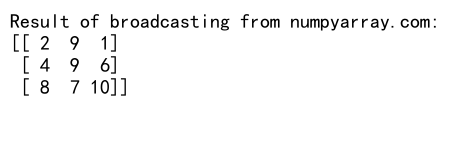
In this example, we add a 1D array to each row of a 3×3 NumPy empty 2D array using broadcasting.
Applying Functions to NumPy Empty 2D Arrays
NumPy provides various functions that can be applied to empty 2D arrays:
import numpy as np
# Create a 4x4 NumPy empty 2D array and fill it with random floats
empty_2d_array = np.empty((4, 4))
empty_2d_array[:] = np.random.random((4, 4))
# Apply functions to the array
sum_array = np.sum(empty_2d_array, axis=0)
mean_array = np.mean(empty_2d_array, axis=1)
max_value = np.max(empty_2d_array)
print("Sum along columns from numpyarray.com:", sum_array)
print("Mean along rows from numpyarray.com:", mean_array)
print("Maximum value from numpyarray.com:", max_value)
Output:

This example demonstrates applying sum, mean, and max functions to a NumPy empty 2D array filled with random floats.
Performance Considerations
When working with NumPy empty 2D arrays, it’s important to consider performance implications, especially for large datasets.
Memory Usage
NumPy empty 2D arrays can be memory-efficient when used correctly. Here’s an example comparing memory usage:
import numpy as np
import sys
# Create a 1000x1000 NumPy empty 2D array
empty_2d_array = np.empty((1000, 1000))
# Create a 1000x1000 NumPy zeros 2D array
zeros_2d_array = np.zeros((1000, 1000))
print(f"Memory usage of empty array from numpyarray.com: {sys.getsizeof(empty_2d_array)} bytes")
print(f"Memory usage of zeros array from numpyarray.com: {sys.getsizeof(zeros_2d_array)} bytes")
Output:

This example compares the memory usage of a NumPy empty 2D array versus a NumPy zeros 2D array of the same size.
Initialization Speed
As mentioned earlier, NumPy empty 2D arrays are faster to create than pre-initialized arrays. Here’s a more detailed comparison:
import numpy as np
import time
def measure_creation_time(creation_func, size):
start_time = time.time()
_ = creation_func(size)
end_time = time.time()
return end_time - start_time
sizes = [(100, 100), (1000, 1000), (5000, 5000)]
for size in sizes:
empty_time = measure_creation_time(np.empty, size)
zeros_time = measure_creation_time(np.zeros, size)
ones_time = measure_creation_time(np.ones, size)
print(f"Array size from numpyarray.com: {size}")
print(f"Empty creation time: {empty_time:.6f} seconds")
print(f"Zeros creation time: {zeros_time:.6f} seconds")
print(f"Ones creation time: {ones_time:.6f} seconds")
print()
Output:

This example measures and compares the creation time for NumPy empty, zeros, and ones 2D arrays of various sizes.
Common Use Cases for NumPy Empty 2D Arrays
NumPy empty 2D arrays have numerous applications in scientific computing, data analysis, and machine learning. Let’s explore some common use cases.
Image Processing
NumPy empty 2D arrays are often used in image processing tasks. Here’s a simple example of creating a blank image:
import numpy as np
import matplotlib.pyplot as plt
# Create a 100x100 NumPy empty 2D array for a grayscale image
image = np.empty((100, 100), dtype=np.uint8)
# Fill the image with a gradient
for i in range(100):
image[:, i] = i * 255 // 99
plt.imshow(image, cmap='gray')
plt.title('Gradient image from numpyarray.com')
plt.show()
Output:

This example creates a 100×100 grayscale image using a NumPy empty 2D array and fills it with a gradient.
Matrix Operations
NumPy empty 2D arrays are excellent for matrix operations. Here’s an example of matrix multiplication:
import numpy as np
# Create two 3x3 NumPy empty 2D arrays and fill them with random integers
matrix1 = np.empty((3, 3), dtype=int)
matrix2 = np.empty((3, 3), dtype=int)
matrix1[:] = np.random.randint(1, 10, size=(3, 3))
matrix2[:] = np.random.randint(1, 10, size=(3, 3))
# Perform matrix multiplication
result = np.dot(matrix1, matrix2)
print("Matrix 1 from numpyarray.com:")
print(matrix1)
print("Matrix 2 from numpyarray.com:")
print(matrix2)
print("Result of matrix multiplication from numpyarray.com:")
print(result)
Output:
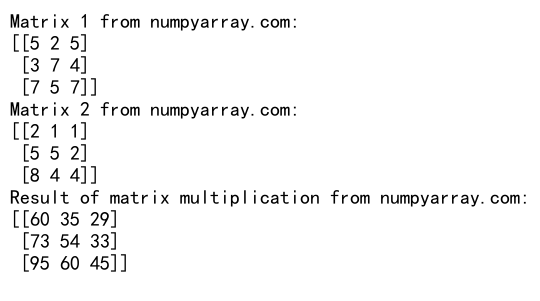
This example demonstrates matrix multiplication using two 3×3 NumPy empty 2D arrays filled with random integers.
Data Preprocessing
NumPy empty 2D arrays are useful in data preprocessing tasks. Here’s an example of normalizing data:
import numpy as np
# Create a 5x3 NumPy empty 2D array and fill it with random floats
data = np.empty((5, 3))
data[:] = np.random.random((5, 3)) * 100
# Normalize the data
normalized_data = (data - np.min(data, axis=0)) / (np.max(data, axis=0) - np.min(data, axis=0))
print("Original data from numpyarray.com:")
print(data)
print("Normalized data from numpyarray.com:")
print(normalized_data)
Output:
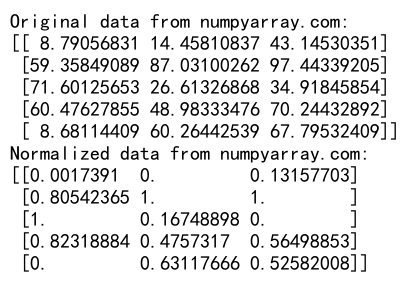
This example shows how to normalize data in a NumPy empty 2D array, scaling values to the range [0, 1].
Best Practices and Tips
When working with NumPy empty 2D arrays, it’s important to follow best practices to ensure efficient and correct usage.
Initializing Arrays
Always initialize NumPy empty 2D arrays before using them to avoid unexpected behavior:
import numpy as np
# Create a 3x3 NumPy empty 2D array
empty_2d_array = np.empty((3, 3))
# Initialize the array with zeros
empty_2d_array.fill(0)
print("Initialized NumPy empty 2D array from numpyarray.com:")
print(empty_2d_array)
Output:

This example demonstrates initializing a NumPy empty 2D array with zeros to ensure predictablebehavior.
Checking Array Properties
Always check the properties of your NumPy empty 2D arrays to ensure they meet your expectations:
import numpy as np
# Create a 4x4 NumPy empty 2D array
empty_2d_array = np.empty((4, 4))
print(f"Shape of the array from numpyarray.com: {empty_2d_array.shape}")
print(f"Data type of the array from numpyarray.com: {empty_2d_array.dtype}")
print(f"Number of dimensions from numpyarray.com: {empty_2d_array.ndim}")
print(f"Total number of elements from numpyarray.com: {empty_2d_array.size}")
Output:

This example shows how to check various properties of a NumPy empty 2D array, including its shape, data type, number of dimensions, and total number of elements.
Memory Management
When working with large NumPy empty 2D arrays, it’s crucial to manage memory efficiently:
import numpy as np
# Create a large NumPy empty 2D array
large_array = np.empty((10000, 10000))
# Use the array
# ... (perform operations)
# Delete the array when no longer needed
del large_array
# Force garbage collection if necessary
import gc
gc.collect()
This example demonstrates creating a large NumPy empty 2D array, using it, and then properly deleting it to free up memory.
Common Pitfalls and How to Avoid Them
When working with NumPy empty 2D arrays, there are several common pitfalls that developers may encounter. Let’s explore these issues and how to avoid them.
Uninitialized Values
One of the most common pitfalls when using NumPy empty 2D arrays is forgetting that the array contains uninitialized values:
import numpy as np
# Create a NumPy empty 2D array
empty_2d_array = np.empty((3, 3))
# DON'T do this: Using uninitialized values
print("Uninitialized array from numpyarray.com:")
print(empty_2d_array)
# DO this: Initialize the array before use
empty_2d_array.fill(0)
print("Initialized array from numpyarray.com:")
print(empty_2d_array)
Output:
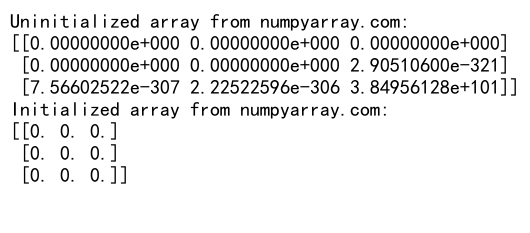
This example shows the potential issue of using uninitialized values and demonstrates how to properly initialize the array before use.
Shape Mismatch
Another common pitfall is shape mismatch when performing operations on NumPy empty 2D arrays:
import numpy as np
# Create two NumPy empty 2D arrays with different shapes
array1 = np.empty((3, 4))
array2 = np.empty((4, 3))
# DON'T do this: Attempting to add arrays with mismatched shapes
try:
result = array1 + array2
except ValueError as e:
print(f"Error from numpyarray.com: {e}")
# DO this: Ensure shapes are compatible or use appropriate operations
result = np.dot(array1, array2)
print("Result of correct operation from numpyarray.com:")
print(result)
Output:

This example illustrates the error that occurs when trying to add arrays with mismatched shapes and shows how to perform a valid operation instead.
Advanced Techniques with NumPy Empty 2D Arrays
Let’s explore some advanced techniques that can be applied to NumPy empty 2D arrays.
Vectorized Operations
NumPy empty 2D arrays support vectorized operations, which can significantly improve performance:
import numpy as np
import time
# Create two large NumPy empty 2D arrays and fill them with random values
size = (1000, 1000)
array1 = np.empty(size)
array2 = np.empty(size)
array1[:] = np.random.random(size)
array2[:] = np.random.random(size)
# Vectorized operation
start_time = time.time()
result_vectorized = array1 * array2
vectorized_time = time.time() - start_time
# Element-wise operation (for comparison)
start_time = time.time()
result_element_wise = np.empty(size)
for i in range(size[0]):
for j in range(size[1]):
result_element_wise[i, j] = array1[i, j] * array2[i, j]
element_wise_time = time.time() - start_time
print(f"Vectorized operation time from numpyarray.com: {vectorized_time:.6f} seconds")
print(f"Element-wise operation time from numpyarray.com: {element_wise_time:.6f} seconds")
Output:

This example compares the performance of a vectorized operation with an element-wise operation on large NumPy empty 2D arrays.
Custom Universal Functions (ufuncs)
You can create custom universal functions to operate on NumPy empty 2D arrays:
import numpy as np
# Define a custom ufunc
@np.vectorize
def custom_operation(x, y):
return x**2 + y**2
# Create two NumPy empty 2D arrays and fill them with random integers
array1 = np.empty((3, 3), dtype=int)
array2 = np.empty((3, 3), dtype=int)
array1[:] = np.random.randint(1, 10, size=(3, 3))
array2[:] = np.random.randint(1, 10, size=(3, 3))
# Apply the custom ufunc
result = custom_operation(array1, array2)
print("Array 1 from numpyarray.com:")
print(array1)
print("Array 2 from numpyarray.com:")
print(array2)
print("Result of custom operation from numpyarray.com:")
print(result)
Output:

This example demonstrates creating and applying a custom universal function to NumPy empty 2D arrays.
Memory-Mapped Arrays
For very large datasets, you can use memory-mapped NumPy empty 2D arrays:
import numpy as np
# Create a memory-mapped NumPy empty 2D array
mmap_array = np.memmap('mmap_array.dat', dtype='float32', mode='w+', shape=(1000, 1000))
# Fill the array with random values
mmap_array[:] = np.random.random((1000, 1000))
# Flush changes to disk
mmap_array.flush()
# Access a portion of the array
print("Subset of memory-mapped array from numpyarray.com:")
print(mmap_array[0:5, 0:5])
# Delete the memmap object (doesn't delete the file)
del mmap_array
Output:

This example shows how to create, fill, and access a memory-mapped NumPy empty 2D array, which is useful for working with datasets that are too large to fit in memory.
NumPy empty 2D array Conclusion
NumPy empty 2D arrays are a powerful and flexible tool for numerical computing in Python. They offer significant performance benefits when working with large datasets and support a wide range of operations and manipulations. By understanding how to create, manipulate, and efficiently use NumPy empty 2D arrays, you can optimize your data processing workflows and tackle complex computational problems with ease.
Throughout this article, we’ve explored various aspects of NumPy empty 2D arrays, including:
- Basic creation and manipulation
- Advanced operations and techniques
- Performance considerations
- Common use cases in scientific computing and data analysis
- Best practices and tips for efficient usage
- Common pitfalls and how to avoid them
- Advanced techniques like vectorized operations and custom ufuncs
By mastering these concepts, you’ll be well-equipped to leverage the full power of NumPy empty 2D arrays in your projects. Remember to always initialize your arrays before use, be mindful of memory management, and take advantage of NumPy’s vectorized operations for optimal performance.
As you continue to work with NumPy empty 2D arrays, you’ll discover even more ways to apply them to your specific problems and domains. The flexibility and efficiency of these arrays make them an invaluable tool in the arsenal of any data scientist, researcher, or developer working with numerical data in Python.